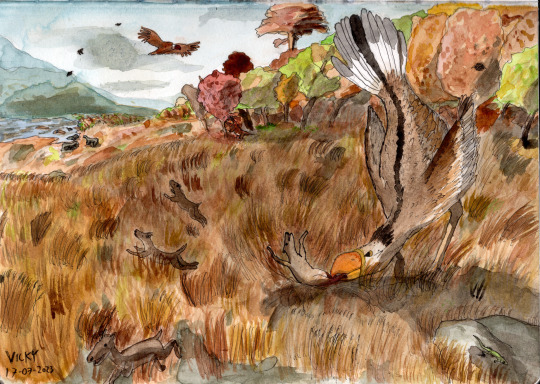#dryornis
Explore tagged Tumblr posts
Text

On the edge of a Miocene South American grassland, a group of Thoatherium is ambushed by a Phorusrhacos. They scatter, but the terror bird catches one of the litopterns, lifts it high up into the air, and SLAMS it down on the ground to kill it. Other nearby animals have mixed feelings about this situation. Tupinambis flees for its life, while Dryornis flies a little closer in case it can have a bit for itself. Hapalops and Astrapotherium are unbothered and have business of their own to take care of.
#phorusrhacos#thoatherium#terror bird#phorusrhacid#litoptern#cariamiform#bird#mammal#santa cruz formation#miocene#neogene#south america#autumn#tupinambis#lizard#squamate#dryornis#new world vulture#accipitriform#hapalops#ground sloth#pilosan#astrapotherium#astrapothere#my art#paleoart#palaeoblr#cw: animal death#cw: blood
78 notes
·
View notes
Text
Flyers and atmosphere

Dryornis by HodariNundu. Its been argued the disappearence of giant flying birds like it is related to the thinning of the atmosphere in the Pleistocene.
A recent study proposes that giant Cenozoic flying birds like pelagornithids, Argentavis, Dryornis and giant storks went extinct due to the thinning of our atmosphere in the late Pliocene/Pleistocene, disallowing them from powered flight.
This is not the first time atmosphere density has been proposed to have affected flying animals. A slightly earlier study suggests that the denser atmosphere of the Eocene allowed bats to develop powered flight, and the denser atmospheres of the Mesozoic have continuously been cited for larger sizes in pterosaurs (a notion paleontologist Mark Witton has continuously disagreed with).
I'm rather conflicted on this. On the one hand, it does seem convenient most large flying birds over 3 meter wingspans disappeared in the Pliocene/Pleistocene transition. On the other hand, the study ignores a recent study on Leptoptilos robustus, which showcases it was still a capable flyer despiste living in the mi/late Pleistocene.
I wonder if the pterosaurian quadrupedal launch would have negated the effects of atmospheric thinning. Certainly, flying machines orders of magnitude larger than any flying mammal still operate, some with relatively small wings.
Food for thought.
8 notes
·
View notes
Text
Dryornis hatcheri Degrange, 2022 (new species)

(Type humerus of Dryornis hatcheri [scale bars = 1 cm], from Degrange, 2022)
Meaning of name: hatcheri = for John B. Hatcher [collector of the original fossil]
Age: Miocene (Burdigalian)
Where found: Santa Cruz Formation, Santa Cruz, Argentina
How much is known: A partial left humerus (upper arm bone).
Notes: D. hatcheri was an American vulture. The type specimen was originally collected in 1899 and thought to have come from a phorusrhacid (terror bird), an assignment that is now considered unlikely given that phorusrhacids were generally flightless birds with very reduced wings. Although the fossil is very fragmentary, it exhibits characteristic features of the genus Dryornis. The only other species of Dryornis that had been previously named was the younger D. pampeanus from the Pliocene of Argentina. Whereas D. pampeanus was the largest known American vulture (estimated as having weighed around 26 kg), D. hatcheri was probably smaller than extant condors, albeit still bigger than most other American vultures.
Reference: Degrange, F.J. 2022. A new species of Dryornis (Aves, Cathartiformes) from the Santa Cruz Formation (lower Miocene), Patagonia, Argentina. Journal of Vertebrate Paleontology advance online publication. doi: 10.1080/02724634.2021.2008411
38 notes
·
View notes
Note
Which fossil cathartids belong to the crown group?
I believe nearly all of them have at least been hypothesized to be crown-cathartids at some point. The only ones I can think of that have been included in phylogenetic analyses and recovered as members of the crown though are Breagyps, Gymnogyps kofordi (in Emslie, 1988), and Dryornis (in Degrange et al., 2021).
2 notes
·
View notes